MARIANI’S
Virtual
Gourmet
March 4, 2018
NEWSLETTER
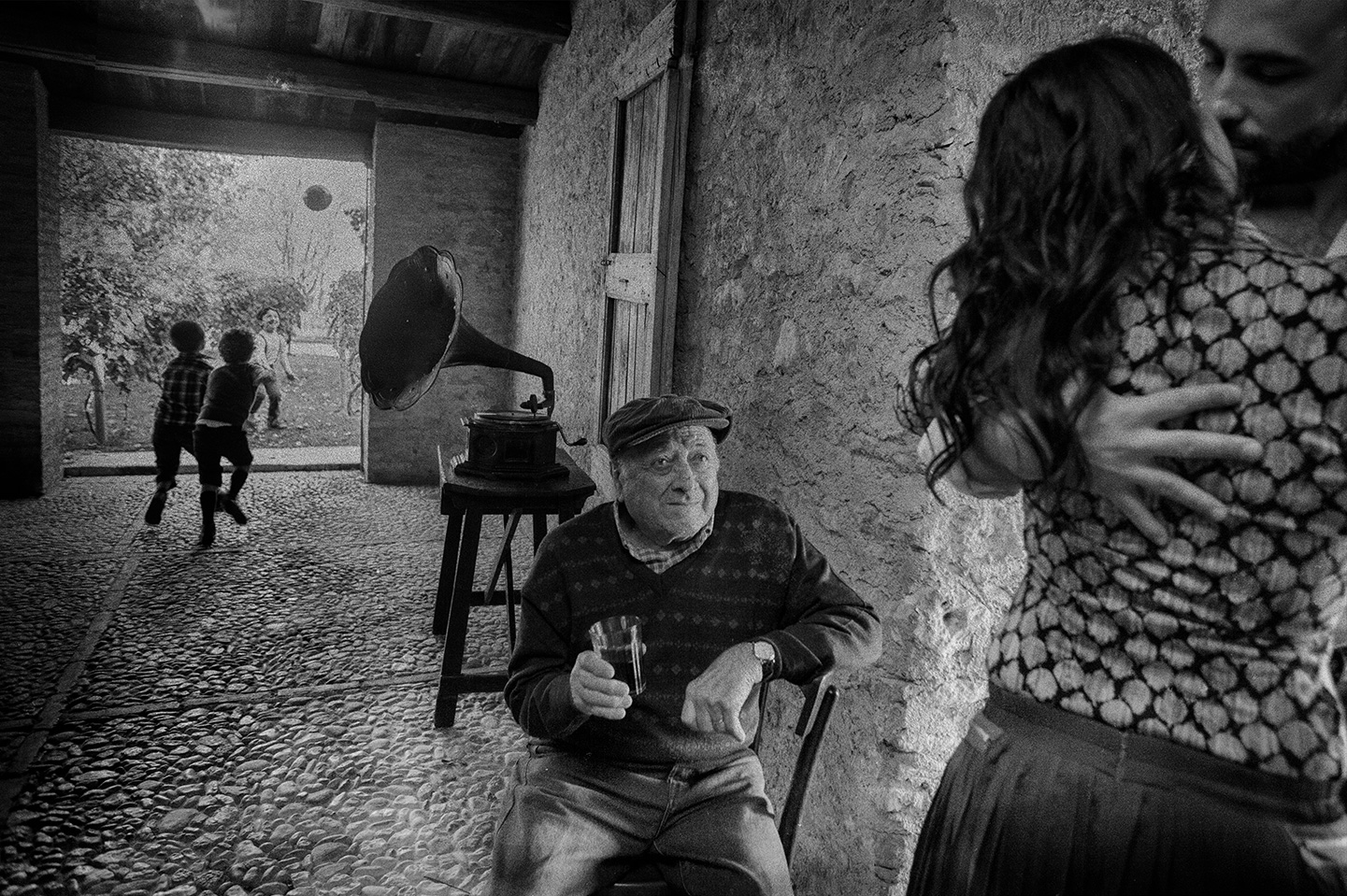
❖❖❖
IN THIS ISSUE
WHERE TO EAT
AROUND WILLIAMSBURG
By John Mariani
NEW YORK CORNER
RIBALTA
By John Mariani
NOTES FROM THE WINE CELLAR
THE CHÂTEAUNEUF-DU-PAPE OF LA NERTHE
By John Mariani
❖❖❖
WHERE TO EAT AROUND
WILLIAMSBURG, VA
By John Mariani
Photos courtesy of Colonial Williamsburg
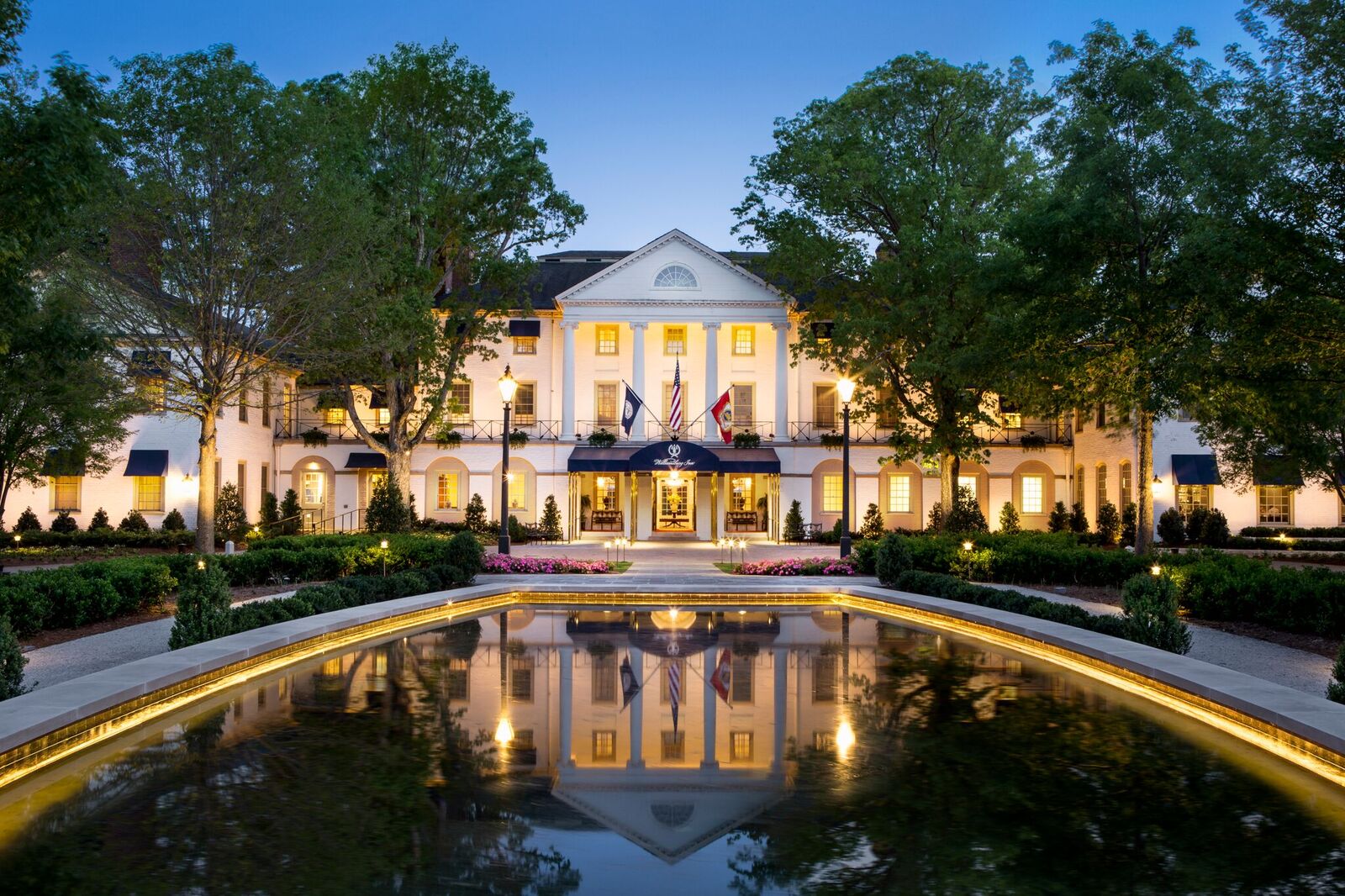
The Williamsburg Inn
It’s not reasonable to
assume that Williamsburg’s culinary landscape is
dotted with country inns of a kind featured at
the Historic Colonial Williamsburg estate. It’s
certainly true that many restaurants capitalize
on that proximity, with names like the Old
Chickahominy House, The Hound’s Tale and Two
Drummers Smokehouse. There’s even an Olde Towne
Pizza & Deli, along with all the usual
chains. But the fare is far more varied in the
area, from fine dining French to sushi and Thai.
Here are some of the more noted examples.
 LE YACA
LE YACA
1430 High Street
757-220-3616
Named after a country
village in the French Alps, Le Yaca was originally
opened by Daniele Bourderau and her husband,
Gerard Gormier, in 1980, though the current High
Street location (there’s also a branch in Virginia
Beach) has been for three years under the
ownership of Chef Daniel Abid and his
wife, Joy,
who have made it into one of the finest French
restaurants in the South.
The sunny décor, with its sandy
colors, copper accents and white
fabric chairs spread over several dining rooms,
evokes Boca Raton more than Williamsburg, but it
fits in with a menu of classic and contemporary
French cuisine, befitting a chef who spent time in
such illustrious French kitchens as Le Pré
Catalan, Moulins des Mougins and Alain Ducasse.
Dishes like Abid’s fennel cream
and bacon soup ($7) and a lovely onion soup ($7)
that’s more like a chowder than a traditional soupe
gratinée, show a light touch, and the crab
cake on buttery spinach was fat with jumbo lumps
of sweet crab and next-to-no filler. Coquilles St.
Jacques ($34) was textbook perfect, the
plump scallops bathed in an impeccably bound
Mornay sauce, and for dessert there was a
tangy-sweet cold lemon mousse with fresh raspberry
sauce ($8).
The $19 three-course lunch is a
remarkable bargain, at dinner $37-$46, with an $80
tasting menu; otherwise, à la carte main courses
run $26-$56.
Open
daily for lunch and dinner.
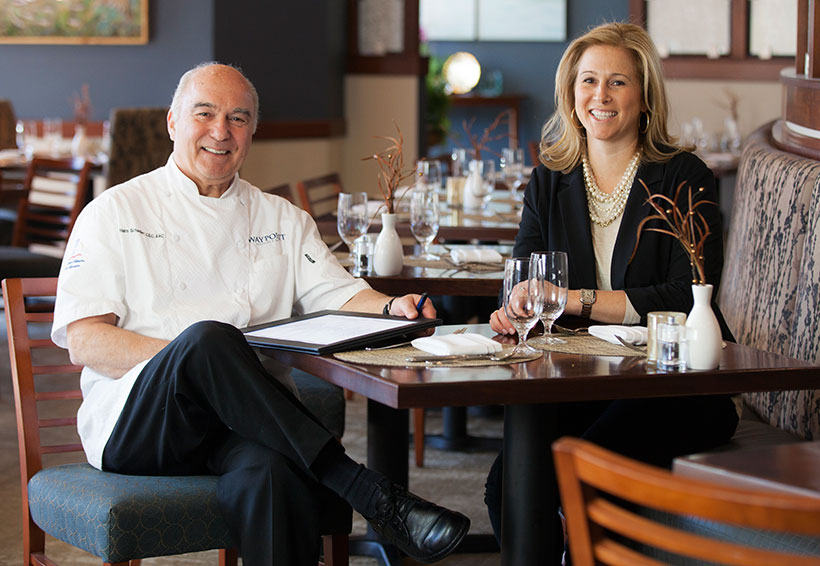 WAYPOINT
INN
WAYPOINT
INN
1480 Quarterpath Road
757-220-2228
The Waypoint Inn is very
much a locals’ favorite and tourist families are
not much in evidence at Chef Hans Schadler’s very
friendly, wide-open brasserie featuring many
dishes from his Frankfort heritage. It
draws an older crowd, but the gemütlich
tenor of the evening is added to by Hans’s wife,
Liv, and daughter Tina Schadler-Phillips (left). Tables
are polished wood, walls are blue-gray, with
hanging orange lanterns and beaded curtains. The
bar is wide open and busy by 5:30.
Schadler was responsible for
coordinating all meal functions during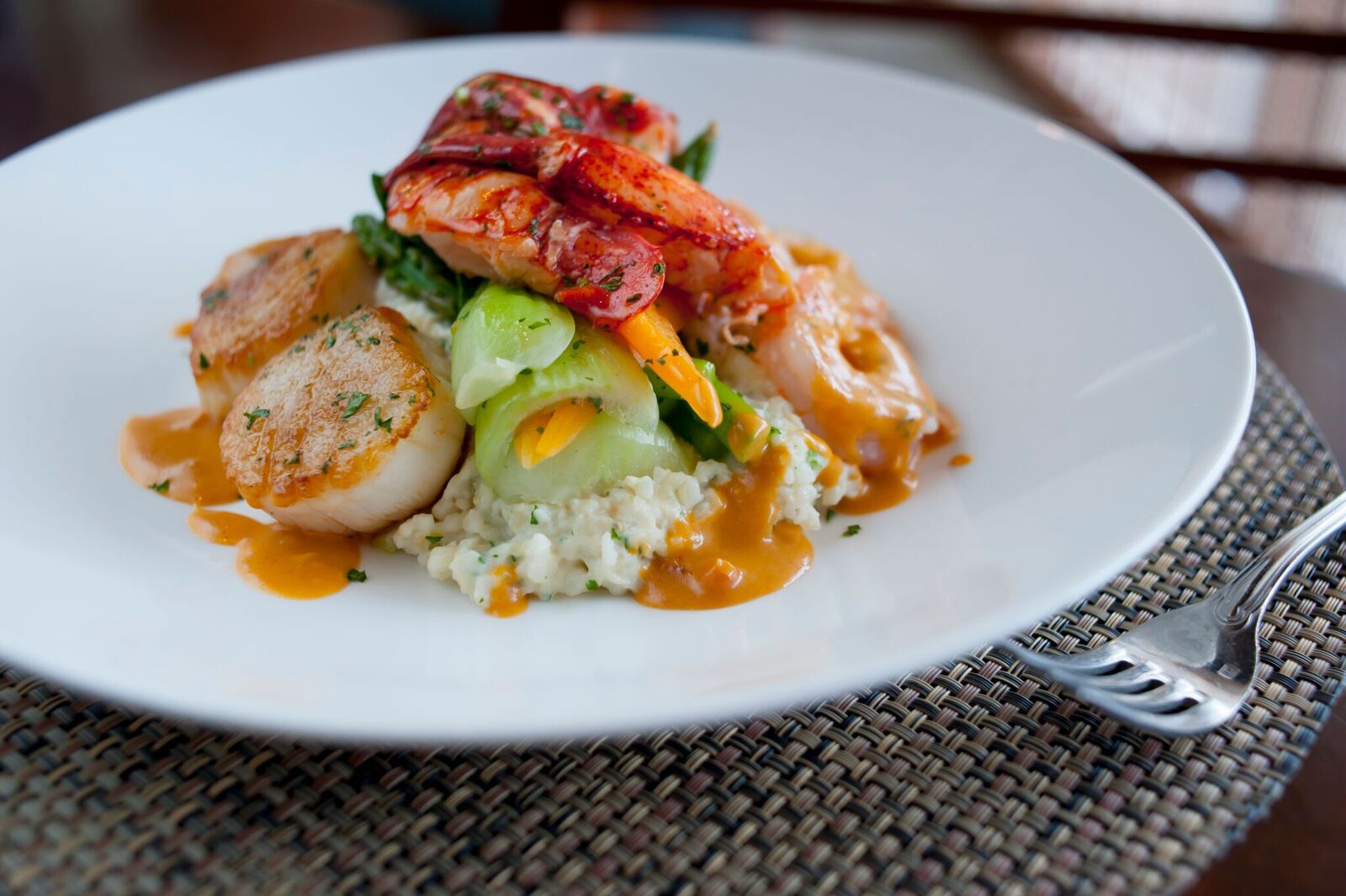 Queen
Elizabeth’s visit to Williamsburg in 2007, and he
prides himself on creating menus where “tradition
intersects creativity.” Waypoint’s wine dinners are
always sold out, as is its celebrated Oktober
Fest.
Queen
Elizabeth’s visit to Williamsburg in 2007, and he
prides himself on creating menus where “tradition
intersects creativity.” Waypoint’s wine dinners are
always sold out, as is its celebrated Oktober
Fest.
Thus, together with executive
chef Steve Perkins, a night at Waypoint might
begin with a lavish charcuterie board ($15) or an
oyster stew dotted with Virginia ham ($14), then
move on to shellfish and grits (right; $30)
or a local fish like puppy drum that might be
crusted with prosciutto and citrus. Oddly
enough, I thought Schadler’s “signature” veal
schnitzel with spaetzle
lacked the crackling crisp crust it should have
had.
For dessert, of course, go with
the warm apple strüdel with walnuts and toasted
cinnamon and rum raisin ice cream ($8.50). The
wine list is not huge but it’s very well priced,
with plenty of good selections under $50.
Open for lunch and dinner
Tues.-Sat.
 ROCKEFELLER ROOM
ROCKEFELLER ROOM
136 Francis Street East
866-299-8521
Recently renovated, Historic
Colonial Williamsburg’s most upscale restaurant,
the Rockefeller Room, remains posh but has changed
from a staid Regency style (it used to be called
the Regency Room) to far more contemporary décor
and colors, with pale gray walls, sconces,
historic photos, soft golden lighting, large ferns
and wonderful, entwined olive green tufted booths
set with roses.
Tablecloths would be a nice touch.
Service personnel recruited
from the famous Inn at Little Washington have
brought the hospitality into the 21st century,
too, and the wine list, always admirable, is being
built into one of the 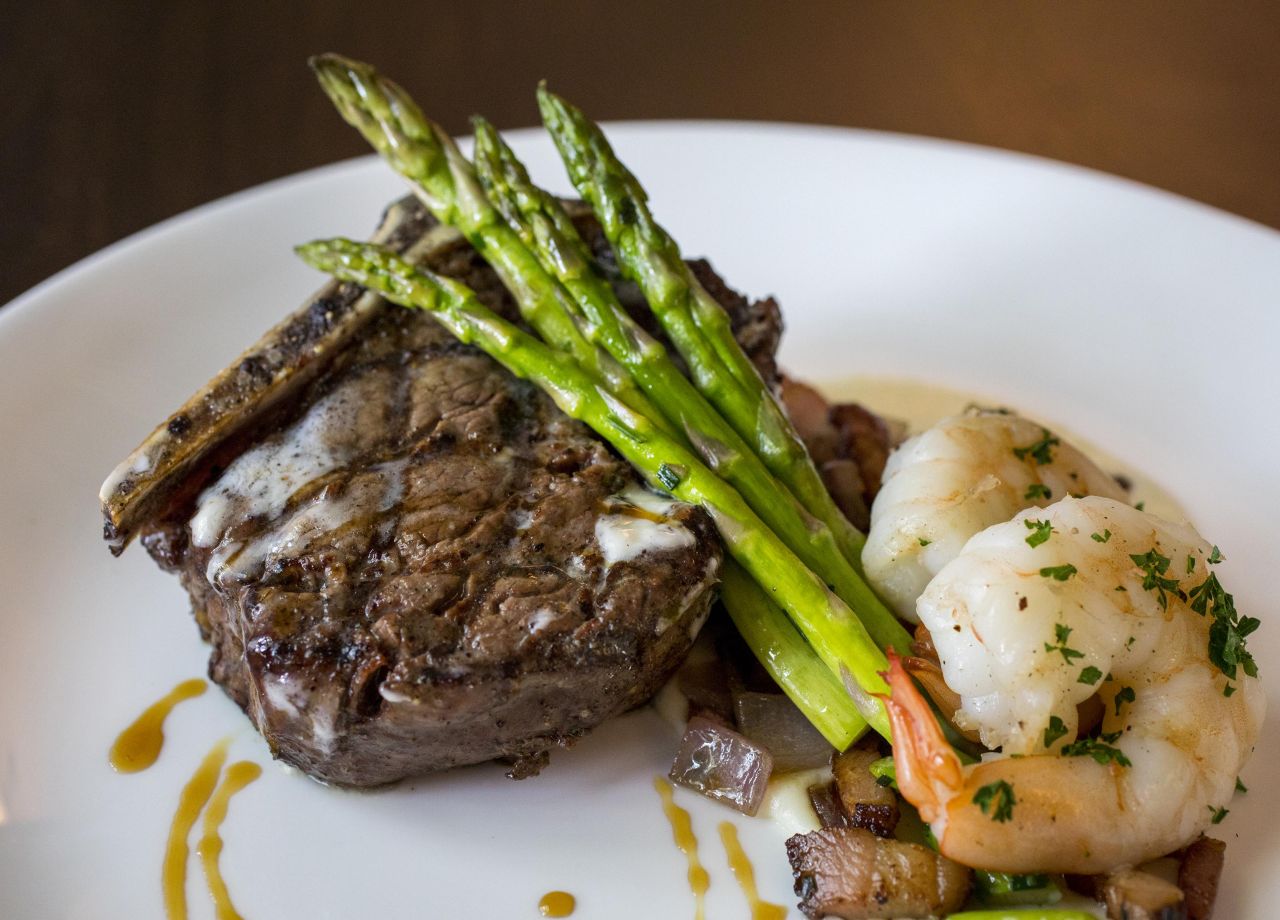 finest in
the region.
finest in
the region.
The current menus straddle the
expected and the novel. Thus, a crabcake
($16)—this one with way too much filler—comes with
a cucumber roulade, while a fine loin of lamb and
shank ($45) are accompanied by a lavender and
chèvre scented potato puree with roasted root
vegetables. The
steaks are of very good quality (right). Things
go awry when dishes are over elaborate, like
kurobuta pork belly with popcorn grits and
something called “sheep’s nose pepper jam.” And
why would the “market fish” of the day be a dull
fillet of lemon sole with lyonnaise potatoes,
fennel and saffron rouille ($36) when so many
better fish swim in the Atlantic?
Desserts are properly lavish—a
croissant bread pudding with blueberry thyme and aigre doux
($19), and a melting chocolate cake with chocolate
cardomon sorbet and red beet gastrique ($8).
Open daily for dinner.
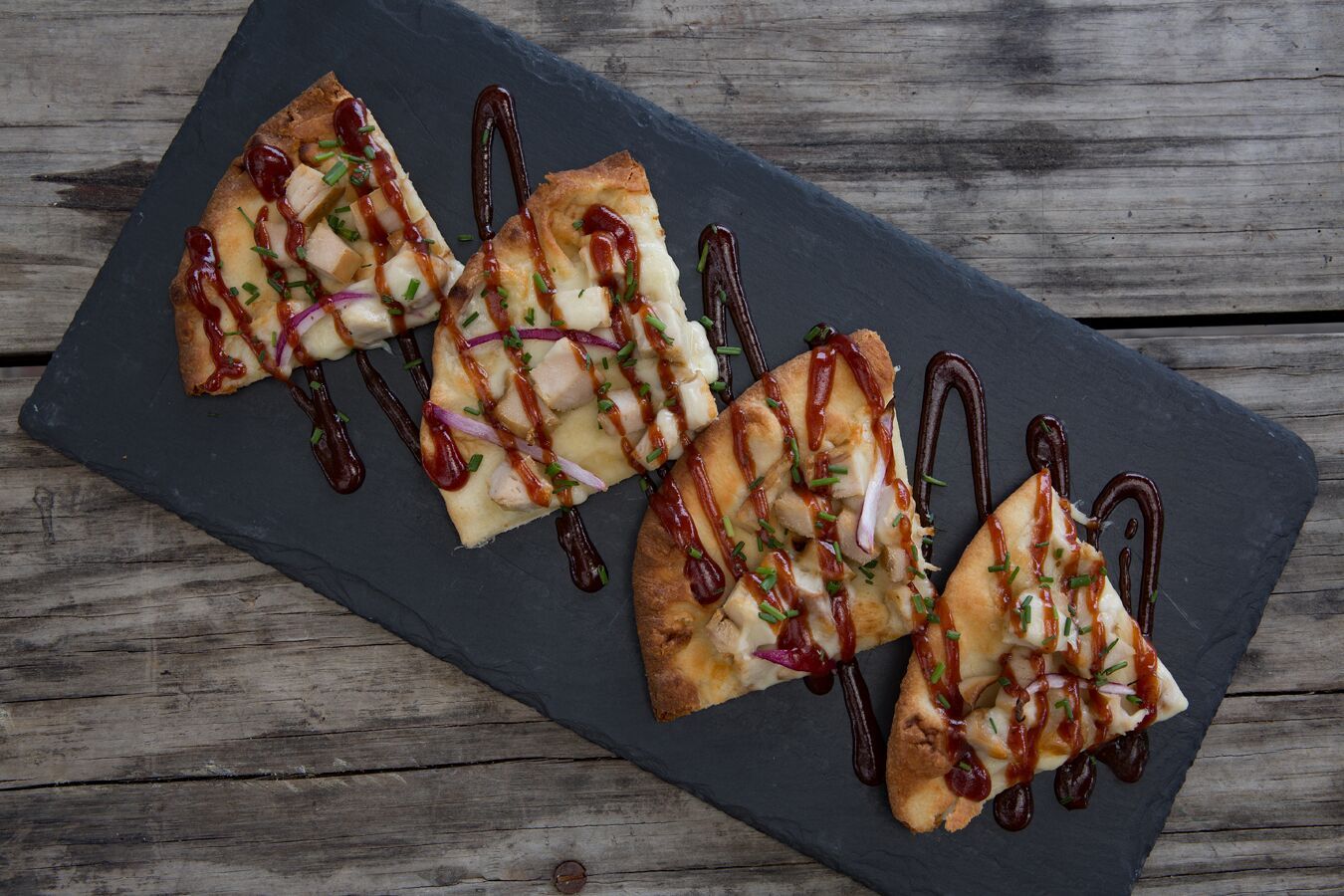 GABRIEL
ARCHER TAVERN
GABRIEL
ARCHER TAVERN
5800 Wessex Hundred
757-229-0999
As I wrote last week, the Williamsburg Wessex
Hundred Winery is well worth visiting, as much for
the wine tours and tastings as for the excellent
lunch-time fare at the Gabriel Archer Tavern,
whose rustic look and rough-hewn tables are apt
surroundings for the hearty American and global
fare offered, from very good flatbreads ($12),
like one with Brie, lingo berry, apple and arugula
(left),
to the lovely sweet potato soup ($7). They make a
creditable Cobb salad with goat’s cheese, feta and
local herbs ($13), and very tasty rockfish tacos
that are chili-spiced and served with shaved
cabbage and red onion slaw, piquillo pepper
remoulade, and local white corn tortillas ($15). The
charcuterie board ($15) is a good idea to share
with various glasses of the estate’s fine wines. You’re
not going to find better food at these prices
anywhere in the area.
Open daily for
lunch
BLUE TALON BISTRO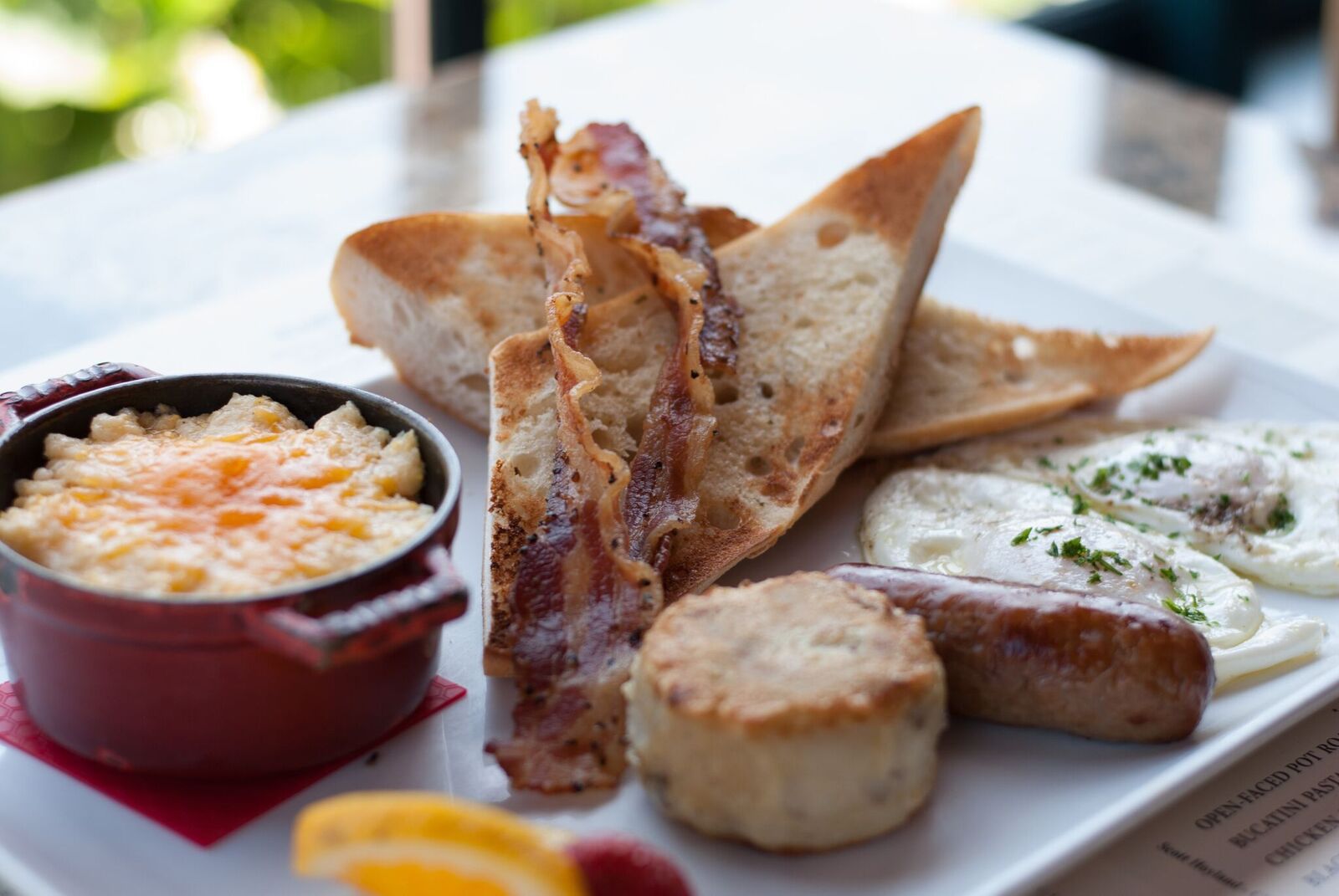
420 Prince George Street
757-476-2583
The warm, welcoming Blue
Talon Bistro, set within the historic district, is
now fourteen years old and gets a crowd throughout
the day. Chef David Everett describes his menu as
“Serious Comfort Food,” which I’ll heartily go
along with.
The room’s country décor evokes a Provençal
French bistro, with its smooth zinc bar, shiny
brass railings, gray marble tables, and waiters in
blue aprons.
At breakfast when I dropped in,
I could tell that everyone in the place seemed to
know each other, the owner and waitstaff, and they
came for the omelettes whose plates brim over with
Cheddar cheese, smoked bacon, sausage, biscuits
and more ($11.95), or the warm croissants ($3.95)
and pain au
chocolat ($3.95). With a good cappuccino, I’ve
rarely had a more sumptuous, delicious first meal
of the day, one that readily tided me over till
dinner.
Later in the day Everett’s menu
grows to include old-fashioned bistro dishes like
escargots
bourguignon in garlic butter ($13.95),
Gruyère-oozing croque madame (($14.95) and even a
salt cod-based brandade
with whipped potatoes, cream and truffle oil
($9.95). There’s a charcuterie plate, and at
dinner you can order steak frites ($29.95),
rotisserie chicken ($24.95) or meatloaf with
mashed potatoes and green beans ($21.95), ending
off with desserts (all $7.95) like gâteau
Bréton caramelized butter cake or Paris-Brest
puff pastry with praline and cream.
Open daily for breakfast, lunch and
dinner.
By John Mariani
48 East 12th Street (near Broadway)
212-777-7781
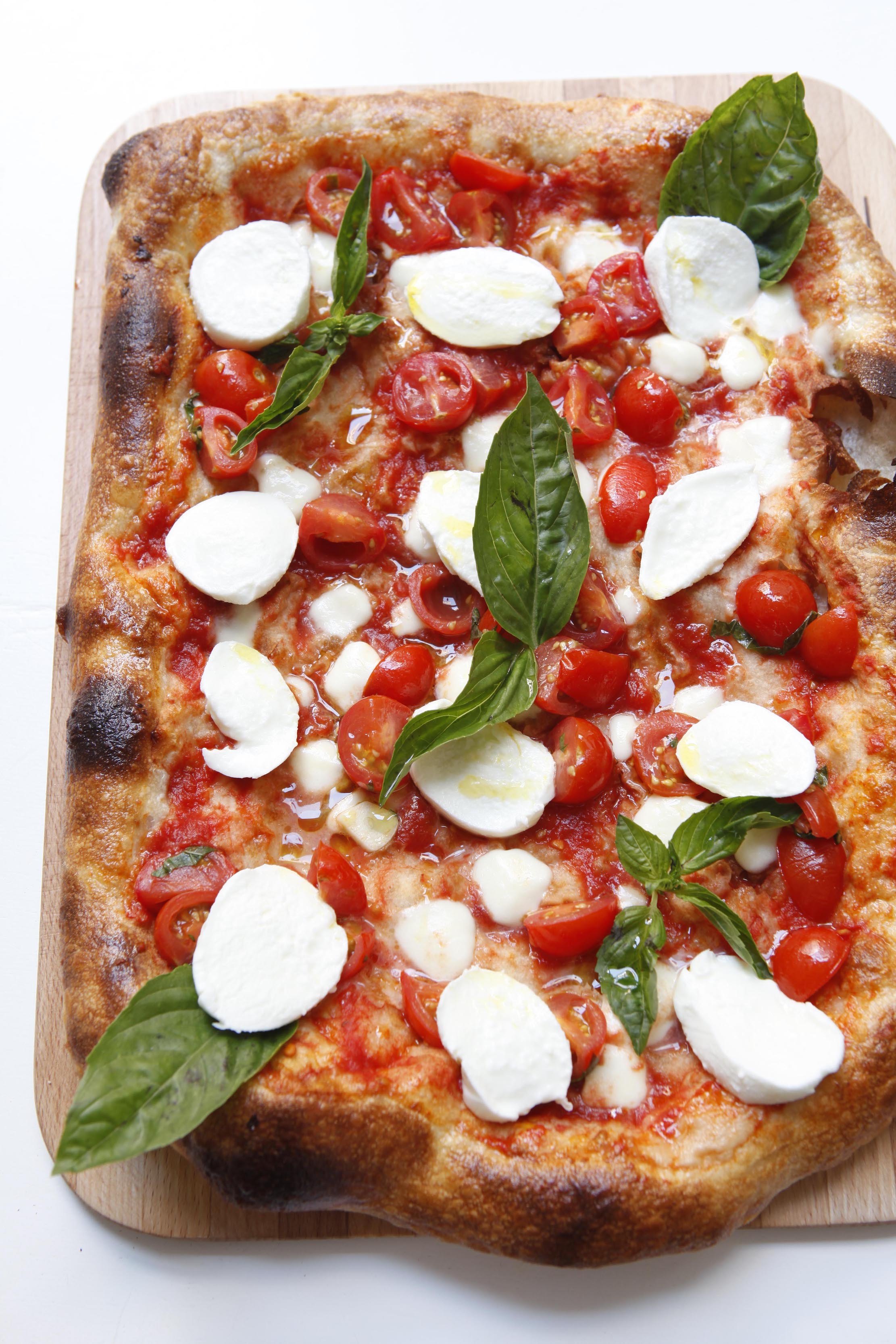
A cliché becomes useless
not because it is untrue but because it becomes
fatuous or all inclusive. So
let me use a cliché about food that I think
cannot be stressed nearly enough: Good food
requires the best, freshest ingredients that
should never be complicated by many others. 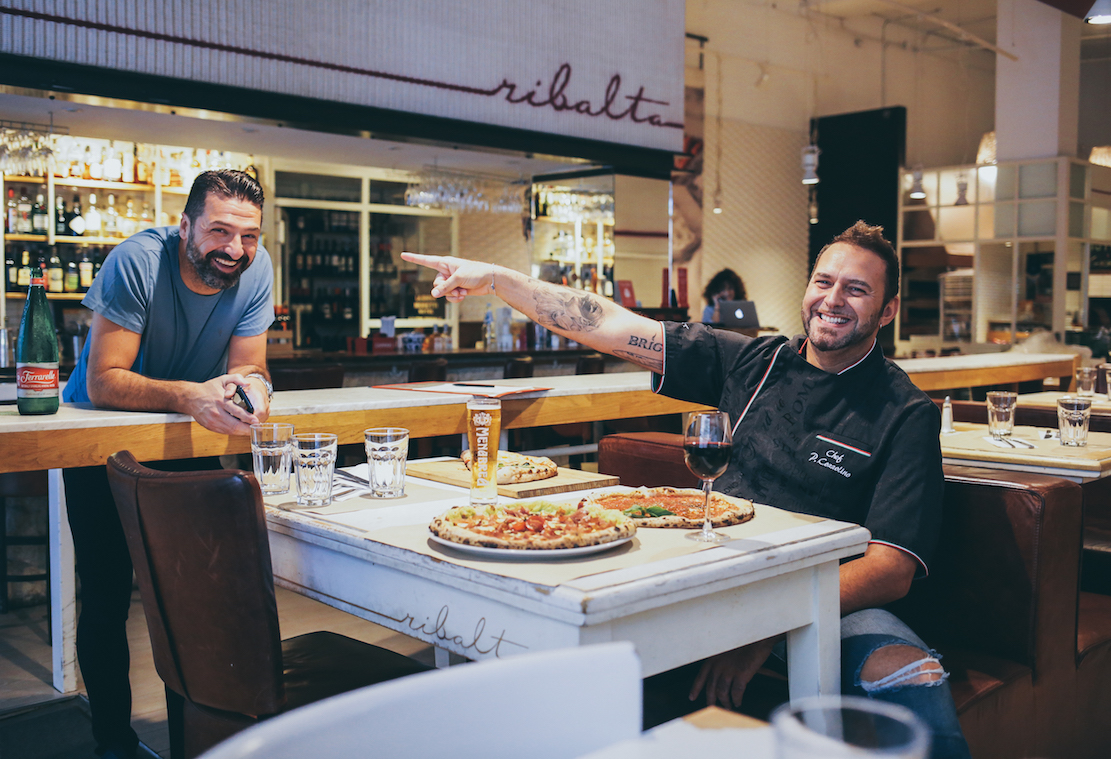
The fact is, despite the
constant repetition of this idea as a promotional
claim, by its very definition there is only a
finite amount of the best, freshest ingredients
available to cooks and restaurateurs, no matter
how much they insist they always buy first-rate
asparagus, Dover sole, wagyu beef and sea scallops
for their printed menus, day after day,
year-round.
I was reminded of this all over
again while dining at Ribalta, the exuberant
pizzeria-trattoria in Greenwich Village run by Rosario
Procino
and Chef Pasquale Cozzolino (right), whose
dedication to making true Neapolitan food is
palpable when you speak to them. “Pizza
was our first food,” says Procino, “We didn’t
really have to learn about it. It’s so basic and
essential to our lives.”
Ribalta’s pizzas are among the
best in NYC, and possibly the very best Neapolitan
versions, because each of a very few ingredients
is nonpareil in its class. The yeast brought from
Italy, called “Le 5 Stagioni,” has for 80 years
gone through a regeneration process every three 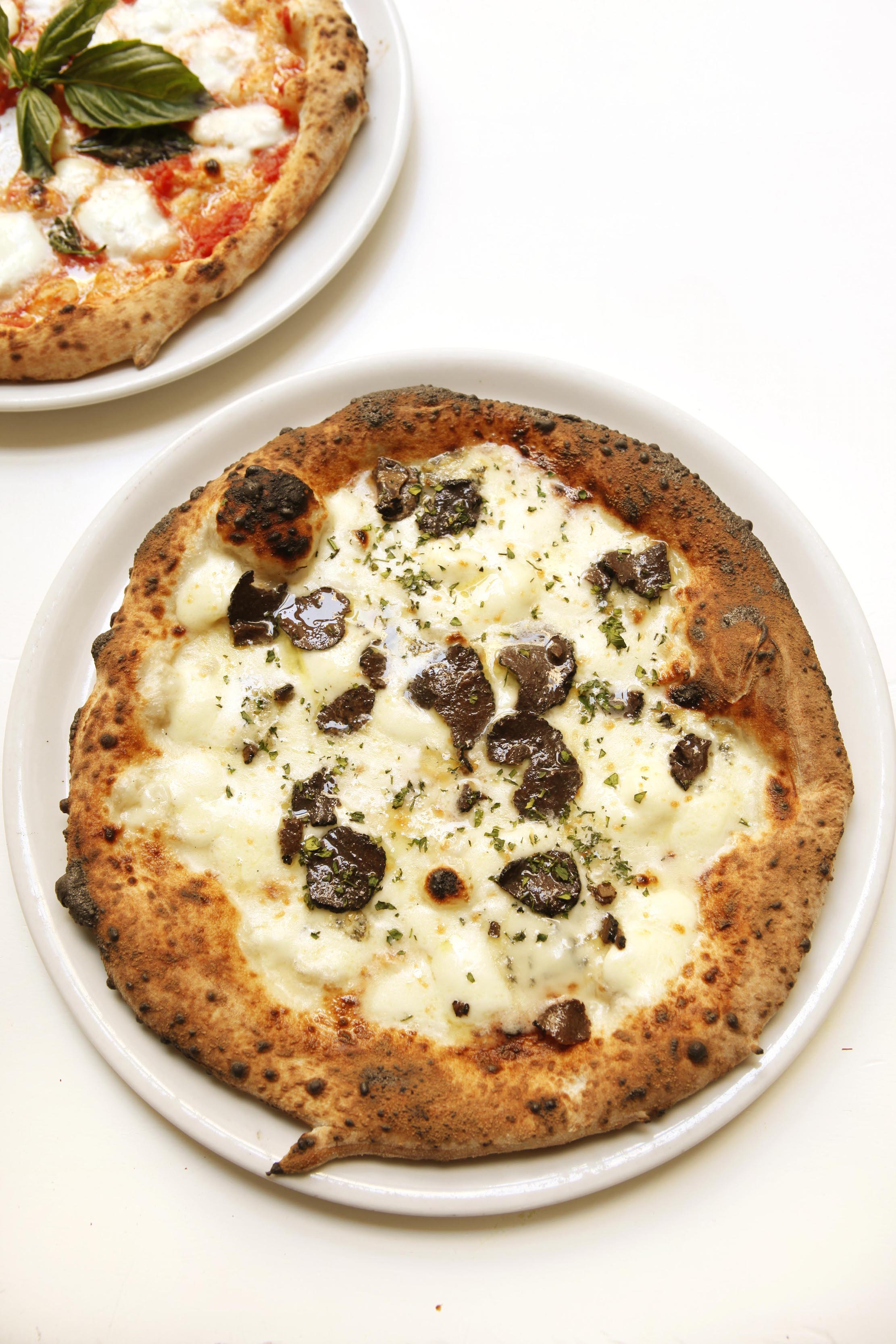 days, resulting in “a lighter, more
balanced pizza.” The dough is Organic Stone Milled
Flour Blend leavened with that yeast for at least
36 hours.
days, resulting in “a lighter, more
balanced pizza.” The dough is Organic Stone Milled
Flour Blend leavened with that yeast for at least
36 hours.
And then there are the
tomatoes; it is indeed a cliché to say that the
tomatoes from around San Marzano, good as they
are, are incomparable. But as Cozzolino proves in
his cooking, the supreme tomatoes of Southern
Italy are called pomodorini del piennolo (below), small
grape tomatoes whose cultivation is restricted to
18 communes around Mount Vesuvius. Their color,
intensity and sweetness are like none other, not
even the very finest vine-ripened tomatoes from a
small California farm.
Once you’ve tasted them on
Ribalta’s simple spaghetti al pomodoro
or atop the pizzas, you will never forget them and
you will compare all others to them. They also
found a place atop one of NYC’s best pizza alla
margheritas, made with imported fior di
latte cheese. Another pie, called Nobile,
was adorned with shaved black truffles, while a
third, in
pala salina, came with imported
ricotta that for once had the real taste and tang
of true buffalo’s milk cheese, along with Sicilian
capers, Gaeta olives and mozzarella. 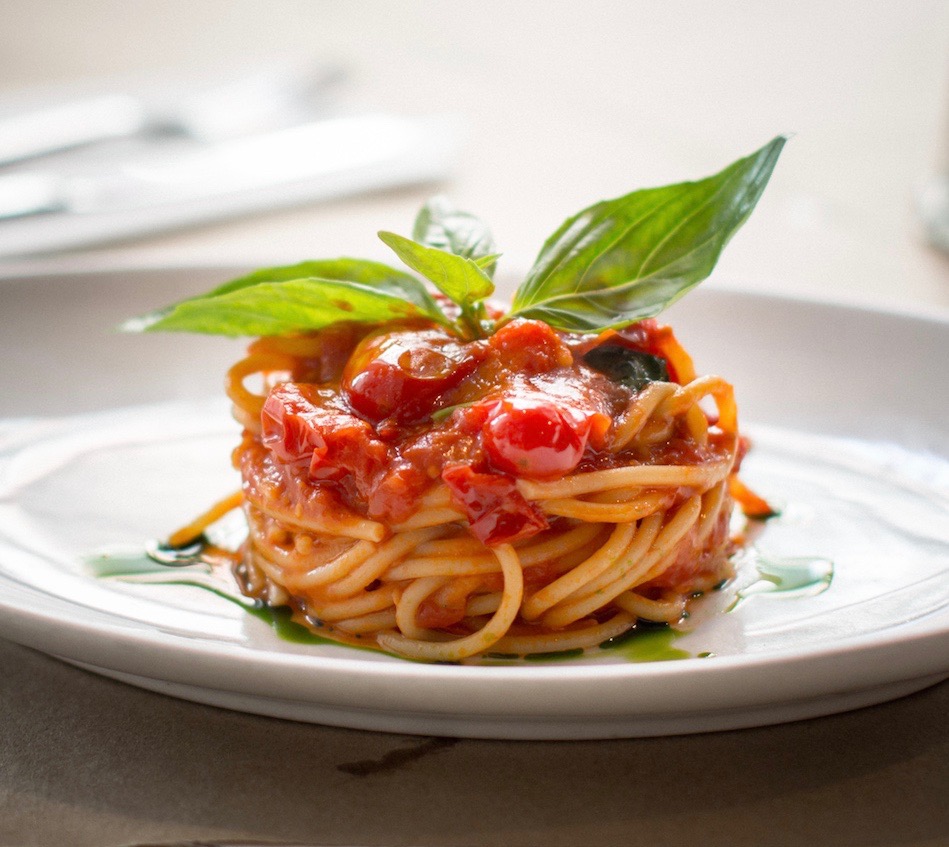
But, before those, we noshed
greedily on golden, crisp, very hot from the fire
potato croquettes, along with zucchine alla
scapece, which were not just impeccably and
quickly fried but which had a shot of housemade
vinegar, mint and garlic to add further taste and
texture.
They make a terrific eggplant parmigiana
in a casserole, a dish once disdained as merely
Italian-American but now becoming very popular in
NYC Italian restaurants. Baby octopus Luciana was a
fabulous and lush dish of the seafood cooked
slowly in San Marzano tomatoes with olives and
capers and set atop a thick slab of toasted
country bread.
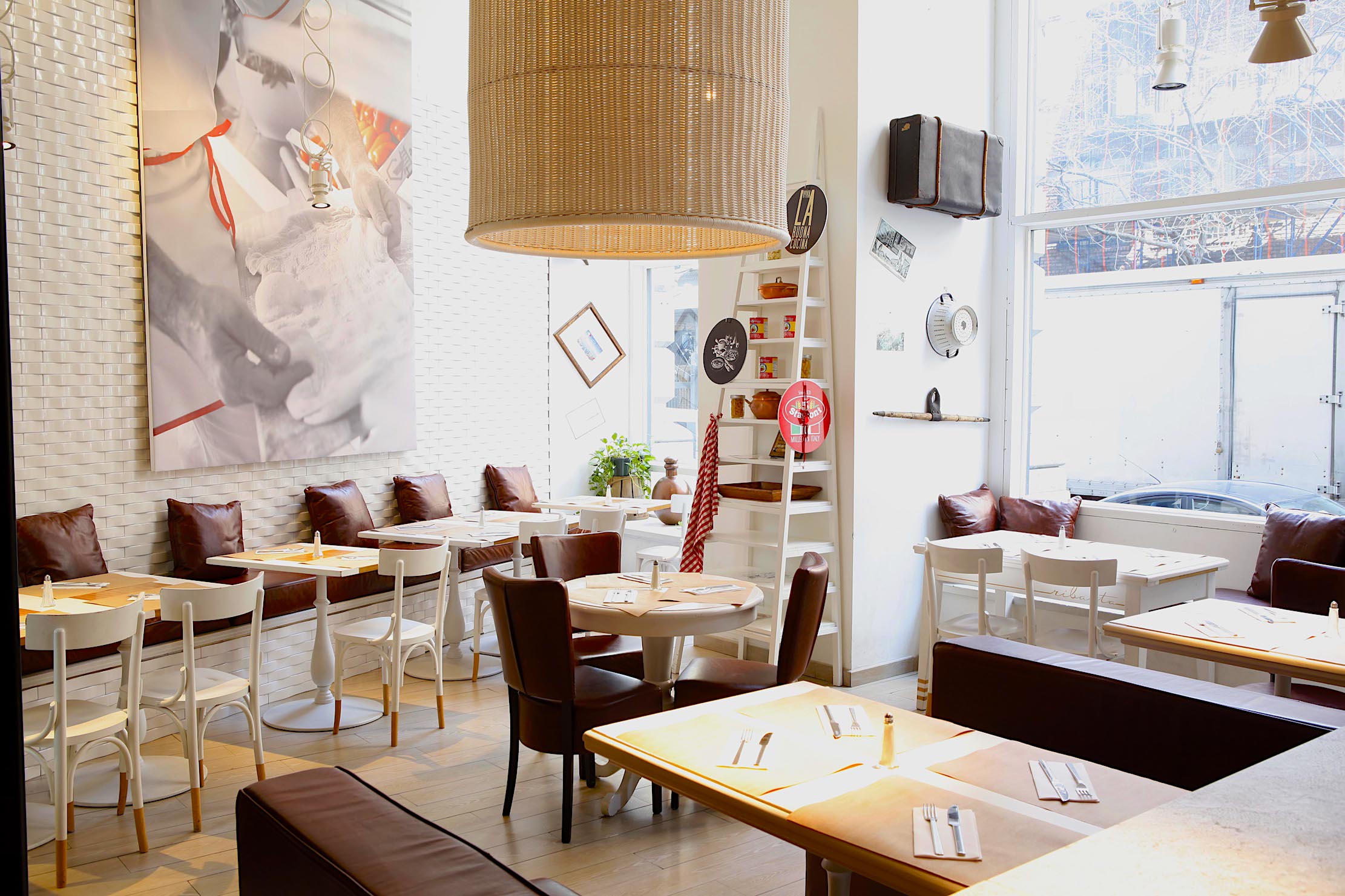 Aside from
the spaghettoni
with those marvelous piennolo tomatoes, we also tried a pasta alla Nerano
with thinly sliced zucchine and
provolone
del Monaco, brought in from the Amalfi
Coast.
Aside from
the spaghettoni
with those marvelous piennolo tomatoes, we also tried a pasta alla Nerano
with thinly sliced zucchine and
provolone
del Monaco, brought in from the Amalfi
Coast.
Desserts are as well conceived
as everything else at Ribalta, including rum-laced
baba slices layered with a tiramisù of
Nutella-enriched mascarpone and topped with
blueberry sauce, along with a deliciously creamy,
crisp Sicilian cannolo. After all
this, I expected the espresso to be made well, and
Rosario’s “special” was everything I could want
and so rarely find elsewhere.
Ribalta’s wine list is
small—about 35 labels—but focused for a trattoria
selection, at very reasonable prices.
The food and wine would be
enough for me to recommend Ribalta as one of NYC’s
best trattorias, but add to that an exuberant
atmosphere that somehow is not as loud as I’d
expected and the presence of Rosario bounding
among the tables, and you have a real experience
as close to anything you’d find in Naples.
❖❖❖
OF LA NERTHE
By John Mariani
Obviously, the wines of
the Rhône Valley are not as familiar to the
average French wine drinker as Champagne,
Burgundy and Bordeaux, but, in fact, there is
considerably more variety there. From the north,
beginning at Vienne, to the south, ending in
Avignon—a distance of only 125 miles—more than
1,800 wineries and 103 cooperatives produce
wines from more than 30 grape varietals, many
rarely grown in the rest of France, like
Bourboulenc, Piquepoul, Carignan and Ugni Blanc.
The
principal grapes include Grenache, Syrah,
Roussane, Mourvèdre, Marsanne, Cinsault and
Viognier, which are blended into a wide range of
classified wines with names like Côte-Rotie,
Condrieu, Crozes-Hermitage and Cornas in the north
and Côtes du Rhône, Châteauneuf-du-Pape, Gigondas,
Lirac and Tavel in the south, where 95% of the
production comes from. In contrast to Bordeaux or Burgundy,
the Rhône does not have an official classification for
"Grand cru" or similar terms.
Among all these varieties, a
lot of poor or mediocre bulk wine is made, labeled
Vin du Pays or Vin de Table, and the cooler
northern region has always had bragging rights for
making more refined reds. Nevertheless,
the brawn of southern Rhône wines, enjoying a more
Mediterranean climate, has long had its own
appeal, while younger winemakers are very busy
doing clonal research to find the best, healthiest
grapes and terroir to make better and better
wines.
Not
until the 1980s did Côtes du Rhone begin to
develop anything close to the
reputation of the more illustrious Bordeaux and
Burgundy. Starting in the 1970s, forward-looking
merchants like E. Guigal (controversial for
introducing new oak to the aging), Jaboulet,
Chapoutier and Delas, modernized the estates,
while winemakers like Gérard Chave, famous for his
Hermitage, became local heroes for their rigorous
commitment to better Rhône wines.
Among the best-known of the
southern Châteauneuf-du-Pape vintners is Château
La Nerthe (right),
whose sloped terroirs of 13 varietals are all
within the company’s estate, which was certified
AB organic in 1998.
The château dates back to 1736, and through
various owners, boom times and bust, it had at
times gone to ruin. But in 1986 the Richard family
bought and renovated the property, now with 222
acres. In 2015 Ralph Garcin, 43, previously at
Jaboulet, took over the estate and its wine
making.
Over a dinner of foie gras
terrine, sea scallops with caviar and chicken with
mushroom fricassée at New York’s Benoit
restaurant, I interviewed Garcin about modern
viticulture in his region. He
explained that La Nerthe uses four to five grapes in its
Chateauneuf-du-Pape, whereas most of his neighbors
use one or two. (Nineteen varieties are allowed to
be used by law, ten red and nine white.) Garcin (left), who
gained his expertise on clonal research while
working for the U.S. Department of Agriculture,
noted that “in the next 20 years we need to find
resistant plants, and, because we are organic, we
use the least amount of spraying. Global warming
has not yet been a problem, but we do careful
pruning and would irrigate only to save a crop
that has been affected by too much heat, which
affects the acids, aromas and phenolic maturity.
We are certainly picking earlier now to avoid the
wines going above 14.5 percent alcohol.”
We began
dinner with a 2016 Châteauneuf-du-Pape Blanc
($60), made from Grenache Blanc,
Roussanne, Clairette and Bourboulenc, with the
Roussanne aged on the lees. It was a fairly easy
vintage with good weather, with the wine reaching
13.5% alcohol, and with its brightness and
tropical fruit flavors went very well with the
scallops and salty roe.
I was very impressed by the
2015 Clos de Beauvenir Blanc, from a large harvest
that was spread over several weeks. It is very
rich, an exemplary white wine from the southern
Rhône, though at $140 it’s at the very high end.
The most basic of La Nerthe’s
red wines is the Châteauneuf-du-Pape Rouge 2015
($60), which I found a very bold, very fruity wine
with a leafy bouquet and, at 14.5% alcohol, years
of improvement yet to come. The blend was 44%
Grenache, 24% Mourvèdre, 18% Syrah, 2% Cinsault
and 2% other grapes, and it was ideal with the
chicken and mushrooms.
La Nerthe makes an array of
other red wines, including some fine
Côtes-du-Rhône Villages, but they also make a very
lovely Prieuré de Montezargués Tavel 2017 rosé
($25), produced in the special microclimate of
the sillon
rhodanien. Many decades ago Tavel was the
wine I’d save to serve with dinner with my
favorite girlfriends instead of Lancers Rosé—the
extra three or four bucks was worth it—but La
Nerthe’s blend of 60% Grenaches blancs and noirs,
20% Syrah, 10% Clairette/Bourboulenc and 10%
Cinsault shows how far Tavel has come. It has a
deep, almost fuchsia color, and there’s plenty of
fruit and floral without being cloying, making it
an ideal aperitif or accompaniment to cold dishes,
goat’s cheese, or salads.
❖❖❖
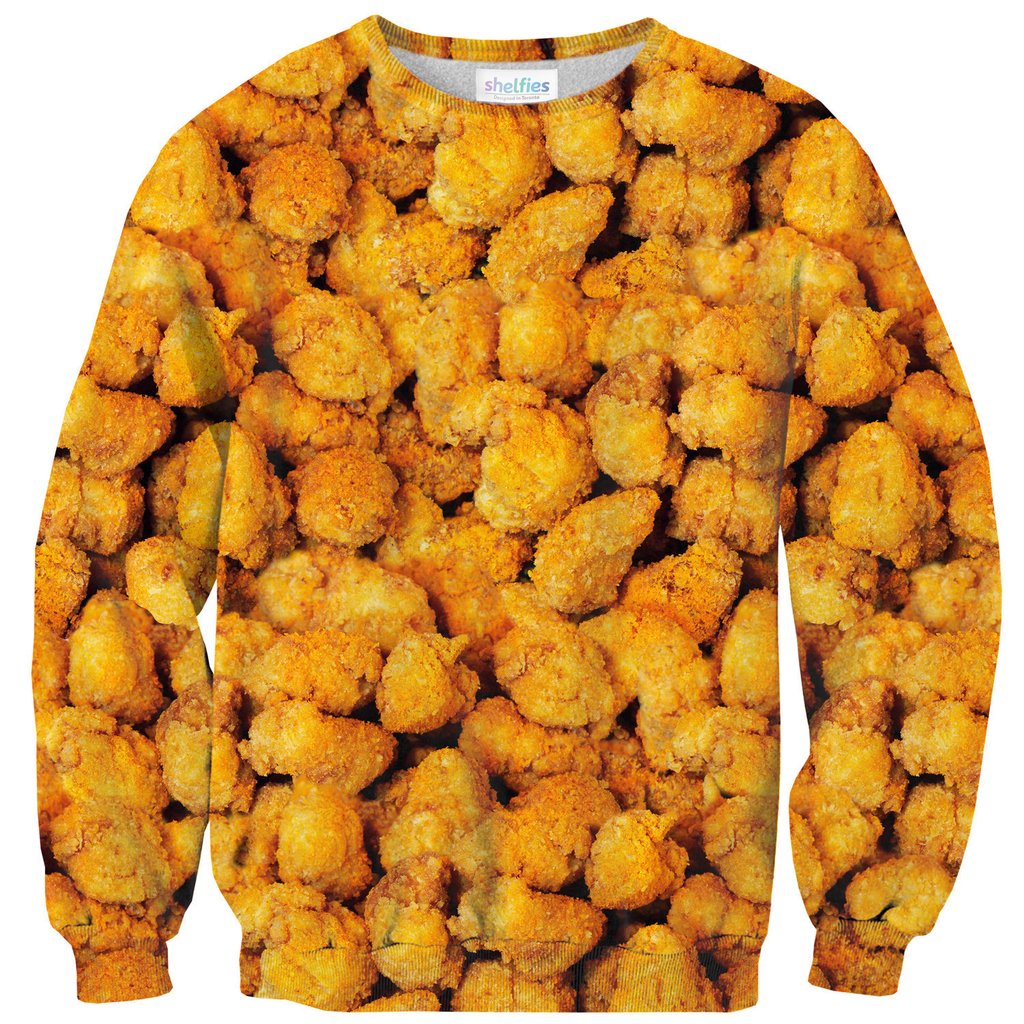
The U.K. is hosting its first
ever Chicken
Nugget festival this summer,
organized by We Love Food, taking
place on August 11 in London and September 22 in
Manchester. According to Metro, with live
bands, DJs, and a chicken nugget eating
competition, where winners are crowned “Nugget
King” and “Nugget Queen” for the day.
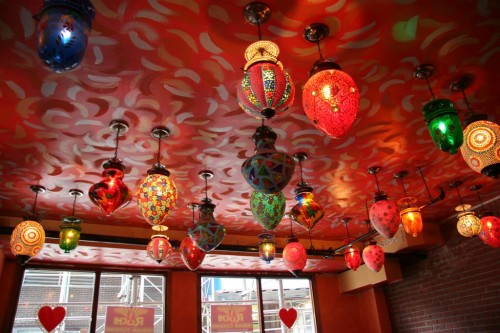
THE QUINTESSENTIAL
HIPSTER RESTAURANT REVIEW
“Ruchi is easy to miss: the dining room and snuggly
fitted into the crook of O’Hara’s, a boomerang shaped
cop and fireman watering hole. The restaurant is marked
only by a faded red vestibule and a pair of plastic
stands that advertise deals--North Indian dishes are
half price at lunchtime on weekdays. Colored glass
lanterns wash the interiors with a warm, effulgent
light, and the mauve shadows they cast seem to demand
you to try something out of the ordinary.”—Nicholas
Niarchos, “Ruchi,” The New Yorker (1/29/18).
Any of John Mariani's books below may be ordered from amazon.com.
 The Hound in Heaven
(21st Century Lion Books) is a novella, and
for anyone who loves dogs, Christmas, romance,
inspiration, even the supernatural, I hope you'll find
this to be a treasured favorite. The story
concerns how, after a New England teacher, his wife and
their two daughters adopt a stray puppy found in their
barn in northern Maine, their lives seem full of promise.
But when tragedy strikes, their wonderful dog Lazarus and
the spirit of Christmas are the only things that may bring
his master back from the edge of despair.
The Hound in Heaven
(21st Century Lion Books) is a novella, and
for anyone who loves dogs, Christmas, romance,
inspiration, even the supernatural, I hope you'll find
this to be a treasured favorite. The story
concerns how, after a New England teacher, his wife and
their two daughters adopt a stray puppy found in their
barn in northern Maine, their lives seem full of promise.
But when tragedy strikes, their wonderful dog Lazarus and
the spirit of Christmas are the only things that may bring
his master back from the edge of despair. WATCH THE VIDEO!
“What a huge surprise turn this story took! I was completely stunned! I truly enjoyed this book and its message.” – Actress Ali MacGraw
“He had me at Page One. The amount of heart, human insight, soul searching, and deft literary strength that John Mariani pours into this airtight novella is vertigo-inducing. Perhaps ‘wow’ would be the best comment.” – James Dalessandro, author of Bohemian Heart and 1906.
“John Mariani’s Hound in Heaven starts with a well-painted portrayal of an American family, along with the requisite dog. A surprise event flips the action of the novel and captures us for a voyage leading to a hopeful and heart-warming message. A page turning, one sitting read, it’s the perfect antidote for the winter and promotion of holiday celebration.” – Ann Pearlman, author of The Christmas Cookie Club and A Gift for my Sister.
“John Mariani’s concise, achingly beautiful novella pulls a literary rabbit out of a hat – a mash-up of the cosmic and the intimate, the tragic and the heart-warming – a Christmas tale for all ages, and all faiths. Read it to your children, read it to yourself… but read it. Early and often. Highly recommended.” – Jay Bonansinga, New York Times bestselling author of Pinkerton’s War, The Sinking of The Eastland, and The Walking Dead: The Road To Woodbury.
“Amazing things happen when you open your heart to an animal. The Hound in Heaven delivers a powerful story of healing that is forged in the spiritual relationship between a man and his best friend. The book brings a message of hope that can enrich our images of family, love, and loss.” – Dr. Barbara Royal, author of The Royal Treatment.
 |
The Encyclopedia of American Food and Drink by John F. Mariani (Bloomsbury USA, $35) Modesty forbids me to praise my own new book, but let me proudly say that it is an extensive revision of the 4th edition that appeared more than a decade ago, before locavores, molecular cuisine, modernist cuisine, the Food Network and so much more, now included. Word origins have been completely updated, as have per capita consumption and production stats. Most important, for the first time since publication in the 1980s, the book includes more than 100 biographies of Americans who have changed the way we cook, eat and drink -- from Fannie Farmer and Julia Child to Robert Mondavi and Thomas Keller. "This book is amazing! It has entries for everything from `abalone' to `zwieback,' plus more than 500 recipes for classic American dishes and drinks."--Devra First, The Boston Globe. "Much needed in any kitchen library."--Bon Appetit. |
"Eating Italian will never be the same after reading John Mariani's entertaining and savory gastronomical history of the cuisine of Italy and how it won over appetites worldwide. . . . This book is such a tasteful narrative that it will literally make you hungry for Italian food and arouse your appetite for gastronomical history."--Don Oldenburg, USA Today. "Italian
restaurants--some good, some glitzy--far
outnumber their French rivals. Many of
these establishments are zestfully described
in How Italian Food Conquered the World, an
entertaining and fact-filled chronicle by
food-and-wine correspondent John F.
Mariani."--Aram Bakshian Jr., Wall Street
Journal.
"Equal parts
history, sociology, gastronomy, and just
plain fun, How Italian Food Conquered the
World tells the captivating and delicious
story of the (let's face it) everybody's
favorite cuisine with clarity, verve and
more than one surprise."--Colman Andrews,
editorial director of The Daily
Meal.com. "A fantastic and fascinating
read, covering everything from the influence
of Venice's spice trade to the impact of
Italian immigrants in America and the
evolution of alta cucina. This book will
serve as a terrific resource to anyone
interested in the real story of Italian
food."--Mary Ann Esposito, host of PBS-TV's
Ciao
Italia. "John Mariani has written the
definitive history of how Italians won their
way into our hearts, minds, and
stomachs. It's a story of pleasure over
pomp and taste over technique."--Danny Meyer,
owner of NYC restaurants Union Square
Cafe, The Modern, and Maialino.
|
 |
 |
 |
 |
 |
 |
 |
 |
 Everett Potter's Travel Report:
Everett Potter's Travel Report: 
 Eating Las Vegas
JOHN CURTAS has been covering the Las Vegas
food and restaurant scene since 1995. He is
the co-author of EATING LAS VEGAS – The 50
Essential Restaurants (as well as
the author of the Eating Las Vegas web site: www.eatinglasvegas.
He can also be seen every Friday morning as
the “resident foodie” for Wake Up With the
Wagners on KSNV TV (NBC) Channel 3 in
Las Vegas.
Eating Las Vegas
JOHN CURTAS has been covering the Las Vegas
food and restaurant scene since 1995. He is
the co-author of EATING LAS VEGAS – The 50
Essential Restaurants (as well as
the author of the Eating Las Vegas web site: www.eatinglasvegas.
He can also be seen every Friday morning as
the “resident foodie” for Wake Up With the
Wagners on KSNV TV (NBC) Channel 3 in
Las Vegas.

MARIANI'S VIRTUAL GOURMET
NEWSLETTER is published weekly. Editor/Publisher: John
Mariani.
Editor: Walter Bagley. Contributing Writers: Christopher Mariani,
Robert Mariani, Misha Mariani, John A. Curtas, Geoff Kalish, Mort
Hochstein, and
Brian Freedman. Contributing Photographer: Galina
Dargery. Technical Advisor: Gerry McLoughlin.
If you wish to subscribe to this
newsletter, please click here: http://www.johnmariani.com/subscribe/index.html
© copyright John Mariani 2017

